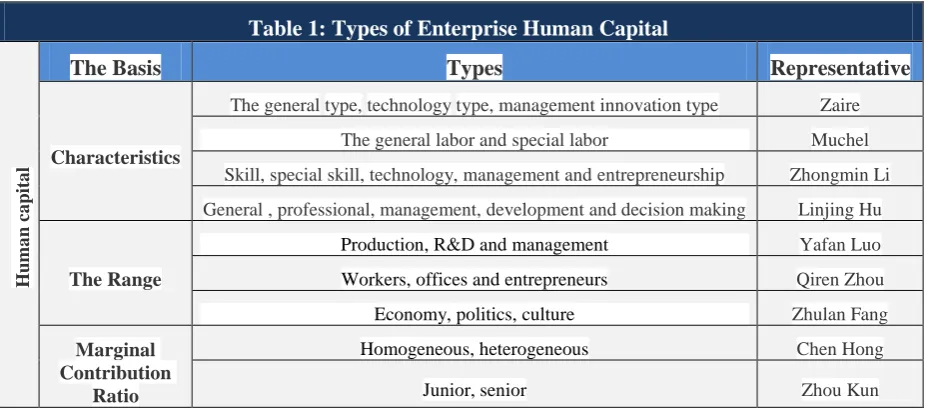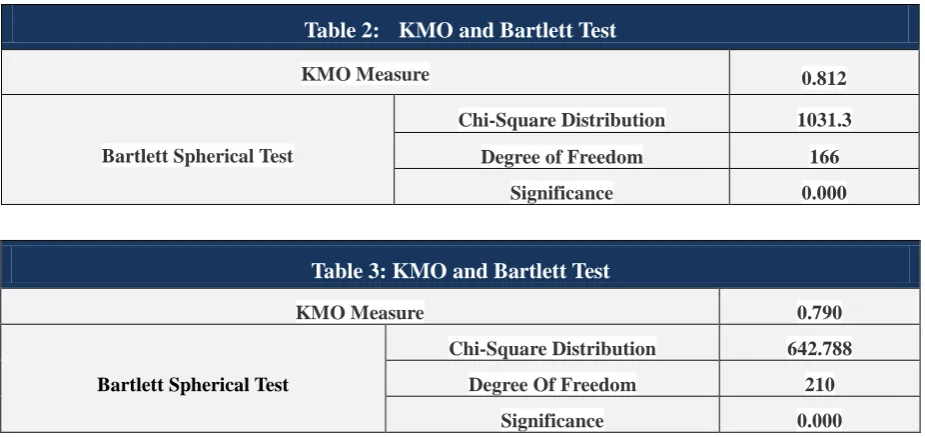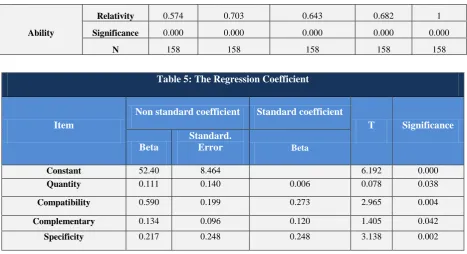SCITECH
Volume 5, Issue 2
RESEARCH ORGANISATION
January 25, 2016
Journal of Research in Business, Economics and Management
www.scitecresearch.com
The Influence of Human Capital on the Enterprise Independent
Innovation Ability
Fan Jia
School of Economics and Management, Nanjing University of Aeronautics and Astronautics, ShengTaiXi Road No.69, Nanjing 211106, China.
Abstract
The ability of independent innovation is the fundamental driving force to improve the actual competitiveness and promote the comprehensive development of enterprises. Human capital is the source of innovation and knowledge has become the most fundamental construction of enterprise independent innovation ability. This article analyzes the human capital mechanism of enterprise independent innovation ability from the perspective of knowledge transformation. We test the hypothesis through empirical research and then draw a conclusion that human capital has a positive effect on enterprise independent innovation.
Keywords
: Enterprise Independent Innovation Ability; Human Capital; Knowledge Transposition.
1.
Introduction
The ability of independent innovation is in relation to the state and enterprise's core competitive ability and is the key factor to the survival and development of enterprises. Under the environment of the economic globalization and the increasing fierce competition today, the ability of independent innovation is the fundamental way for enterprises to obtain and maintain competitive advantage. At the same time, improving the ability of independent innovation of enterprises in China to achieve industrial upgrading and build an innovation oriented country is of great significance. Innovation is the soul of an enterprise and human capital is the source of innovation[1]. With the development of human society and the coming of knowledge economy, human capital will become the strategic resources of modern enterprises, which is the most critical factor[2]. In the early 1960s, the USA economist Theodore, W Schultz[3] proposed the concept of human capital. He thought that different from material capital, human capital is reflected in the human body, which can be used to provide a capital of future revenues for human beings in economic activities and has the ability of continuously value-added gains. Since the research about the human capital in China is not mature, the definition of human capital is referred to Theodore W Schultz. Human capital is the condensation in the human body, which can be materialized on goods or services and which increases the utility of goods or services and consists of the benefits of value.
2.
Review of Literature
2.1 Human Capital
Human capital is a general term for workers who put into knowledge, technology, innovative concepts and management methods. It is found that workers make the value of stock value proliferation through investment. Enterprise human capital depends on the staff, but due to different human capital investment process and output effect, there is the difference in quality and quantity among different employees owning human capital, therefore, human capital should be classified. In the existing research results, scholars have different views on the classification of human capital, this paper summaries it as follows.
At the same time, it is of great advantage to study the relationship between human capital and enterprise other elements[4]. This paper will divide the human capital measurement into four dimensions, including quantity of human capital, compatibility of human capital and organization, complementary of human capital and specificity of human capital.
2.2 Enterprise Independent Innovation Ability
Table 1: Types of Enterprise Human Capital
H
um
a
n
ca
pita
l
The Basis
Types
Representative
Characteristics
The generaltype,technologytype, management innovation type Zaire
The general labor andspecial labor Muchel
Skill, special skill, technology, management and entrepreneurship Zhongmin Li
General , professional, management, development and decision making Linjing Hu
The Range
Production, R&D and management Yafan Luo
Workers, offices and entrepreneurs Qiren Zhou
Economy, politics, culture Zhulan Fang
Marginal Contribution
Ratio
Homogeneous, heterogeneous Chen Hong
Junior, senior Zhou Kun
According to Joseph Alois Schumpeter, innovation is to build a new product function. The so-called independent innovation refers to innovation based on self-innovation capability, which has three implications: the first is the original innovation that is to obtain more scientific discoveries and technological inventions through their own efforts; the second is the integrated innovation, making all sorts of related techniques organically integrated and aggregating competitive products and industry; the third is actively promoting digestion and absorption and re-innovation based on the introduction of foreign advanced technology[5]. In regard to the connotation of independent innovation, the academic researchers at home have generally formed a consensus, i.e., the innovation includes the original innovation, integrated innovation and the introduction of technology based on the digestion and absorption of re-innovation or imitation innovation.
Regarding to the independent innovation of enterprises, domestic and foreign scholars have done a lot of researches mainly around two directions, one is focused on the countries and regions from the macroscopic angle and the other is focused on the micro enterprises.
The researchers have surveyed the enterprise independent innovation ability in different views. Adler, Shenbar and Burgelman studied the ability of independent innovation of enterprises from the structure of enterprise technology ability. Guisheng Wu made a study of enterprise independent innovation ability from the five parts of innovation including input ability, research and development ability, production ability, marketing ability and management ability. After that, Ruijun Wen conducted empirical research about independent innovation ability of Zhejiang province enterprises and the enterprise capability of independent innovation is mainly evaluated from the five aspects: the ability of research and development, manufacturing capability, marketing capability, resources management ability and management ability. Zhiyong Xia designed the enterprise measurement system of independent innovation ability in his independent research involving development ability, independent production ability and self-management ability[6]. Genli Tang selected the R&D capability, manufacturing capability, marketing ability and organizational management capabilities from the perspective of innovation process through analyzing the factors which influence the enterprise ability of independent innovation and measuring the ability of independent innovation enterprises. He constructed a set of enterprise independent innovation ability evaluation index system[7]. Wei-dong Zhu defined the connotation of enterprise independent innovation ability and further pointed out the four dimensions of enterprise independent innovation ability, that is, independent innovation impetus, resource conformity ability, independent innovation output capacity and sustainable ability of independent innovation[8].
3.
Research Hypothesis
Human capital and innovation are closely related and human capital is the source of improving the innovation ability of enterprises[9]. From the accumulation of human capital to the formation of innovation ability of enterprises, this process depends on the effectiveness of human capital management, which can not only enhance labor innovation quantity but also can improve the quality. Good human capital management is helpful to promote enterprise innovation[10].
Jianjun Ding put forward that the specific human capital accumulation is the source of enterprise innovation and higher value of specific human capital claims for more investment to knowledge staff. Guangke Zhang thought that knowledge expansion ability rooted in enterprise human capital and determined the level of independent innovation capability. Knowledge expansion ability of human capital is decided by the demand of knowledge, learning, income and substitution effect, which is affected by the enterprise human resources management activities[11]. Qiuwen Huang's research showed that human capital was conducive to knowledge and technology transfer contributed to the development of new products and improved the degree of innovation. In the process of innovation, knowledge type talent is playing a key role and sometimes even decisive role. It is not difficult to find results from the above research that human capital plays an important role in the construction of enterprise independent innovation ability and the knowledge factor does the same. Knowledge or the know-ledge innovation is the foundation of enterprise independent innovation ability. Therefore, human capital has a positive effect on the construction of the enterprise independent innovation ability.
According to the above analysis and research, this paper also gives the following hypothesis:
H: human capital has a positive effect on enterprise independent innovation ability.
H1: the quantity of human capital has a positive effect on enterprise independent innovation ability.
H2: the compatibility of human capital and organization has a positive effect on enterprise independent innovation ability.
H3: the complementary of human capital has a positive effect on enterprise independent innovation ability.
H4: the specific human capital has a positive effect on enterprise independent innovation ability.
4.
Research Methods
The scales of all items adopt Likert 7 point scale method, ranging from "strongly agree" to "totally oppose to". Among them, the measurement of human capital in this paper is mainly based on the Edvinsson, Malone Sveiby and Stewart scale, which mainly has four indexes: quantity of human capital, compatibility of human capital and organization, complementary of human capital, specificity of human capital. There are 3 main indicators to measure the enterprise independent innovation ability: knowledge learning ability, knowledge application ability and know-ledge innovation ability[12].
We transform the above measurement indicators into questionnaires and asked respondents to fill out according to the actual situation. After that, SPSS19.0 is used for statistical analysis of each variable and hypothesis test of the model. We put out 200 questionnaire copies and reject unqualified questionnaires. 158 valid questionnaires were collected and the effective recovery rate is 79%. Among them, from the nature of the surveyed companies, 14 state-owned and state-holding enterprises, accounting for 50% of the total; 8 private and join stock enterprises, accounting for 28.6% of the total; 4 foreign-funded enterprises, accounting for 14.3% of the total; the other 2, accounting for 0.07% of the total. In addition, from the enterprise scale, the industry distribution and investigators position with a wider distribution better representation will be able to satisfy the needs of study.
5.
Empirical Analysis
Table 2: KMO and Bartlett Test
KMO Measure 0.812
Bartlett Spherical Test
Chi-Square Distribution 1031.3
Degree of Freedom 166
Significance 0.000
Table 3: KMO and Bartlett Test
KMO Measure 0.790
Bartlett Spherical Test
Chi-Square Distribution 642.788
Degree Of Freedom 210
Significance 0.000
The overall alpha coefficient of enterprise independent innovation ability of the scale is 0.813, the KMO and Bartlett results are shown in Table 3.
The above variables and measurement indexes meet the requirements, indicating that the questionnaire has good reliability and validity. This research adopts the method of multiple linear regressions to analyze the relationship between human capital and enterprise independent innovation ability. Based on the relationship we build the regression model and analyze the relationship between these two research variables to verify the research hypothesis. In order to simplify the analysis process, this paper will make a single treatment of the ability of enterprises independent innovation, at the same time, we carry out a test before multiple regression analysis between the 4 dimensions of human capital and two variables of enterprise independent innovation ability. Pearson correlation coefficient is close to 1, indicating that there is a significant positive correlation between the variables.
Table 4 shows that there is a positive correlation between the 4 dimensions of human capital. Multiple regression analyses are performed on the human capital and the enterprise independent innovation ability, with the results in Table 5 shows the results of regression analysis, the significant level of 4 dimensions of human capital value of less than 0.05, and the regression coefficient of each dimension of enterprise independent innovation ability are positive.
Table 4: Correlation Matrix
Quantity Compatibility Complementary Specificity Ability
Quantity
Relativity 1 0.458 1.545 0.403 0.574
Significance 0.000 0.002 0.000 0.000 0.000
N 158 158 158 158 158
Compatibility
Relativity 0.458 1 0.490 0.538 0.703
Significance 0.000 0.000 0.001 0.000 0.000
N 158 158 158 158 158
Complementary
Relativity 0.545 0.490 1 0.566 0.643
Significance 0.000 0.000 0.000 0.000 0.000
N 158 158 158 158 158
Specificity
Relativity 0.403 0.538 0.566 1 0.682
Significance 0.000 0.002 0.000 0.000 0.000
N
Ability
Relativity 0.574 0.703 0.643 0.682 1
Significance 0.000 0.000 0.000 0.000 0.000
N 158 158 158 158 158
Table 5: The Regression Coefficient
Item
Non standard coefficient Standard coefficient
T Significance
Beta
Standard.
Error Beta
Constant 52.40 8.464 6.192 0.000
Quantity 0.111 0.140 0.006 0.078 0.038
Compatibility 0.590 0.199 0.273 2.965 0.004
Complementary 0.134 0.096 0.120 1.405 0.042
Specificity 0.217 0.248 0.248 3.138 0.002
It can be judged that human capital has a positive effect on enterprise independent innovation ability. The result is consistent with the former research[13]. While in this research, we considered the four dimensions of human capital and among them, compatibility of human capital and organization plays the most important role on the ability of independent innovation enterprises; the second is of specific human capital, complementary and quantity of human capital human capital influence on enterprise independent innovation ability of the least effect. Then, the basic assumptions presented in this paper are verified.
6.
Conclusions and Enlightenment
Nowadays, along with the knowledge economy tide, the human capital is the core capital of enterprise. The empirical research about the relationship between human capital and enterprise independent innovation ability delivers some important messages to us. On the one hand, human capital has been becoming the critical factor of the ability of enterprise innovation, which is the key element of the enterprise development. On the other hand, this article has analyzed the effect of human capital on enterprise independent innovation ability from four parts of human capital, which will provide a specific illustration for people. First, the quantity of human capital, the compatibility of human capital and organization, the complementary of human capital and the specific human capital are all the factors for the independent ability of innovation in the enterprises. Second, the compatibility of human capital and organization is the most important factor of all to the enterprise independent innovation ability. Since human capital is important, the compatibility emphasizes its fitness for a company and thus the choice and introduction of human capital is a important link. Third, though the importance of other three factors account for enterprise innovation ability less than the importance of compatibility of human capital and organization, we can’t ignore their functions.
Therefore, considering the findings above, we should strengthen the reform of innovation incentive mechanism and encourage the talents from the root through advocating the option incentive to obtain permanent creativity and to enhance the capability of independent innovation of enterprises. In this study, it will help enterprises make a reasonable integration and configuration according to their own situation of human resources and it will contribute some enlightenment about innovation for the development of enterprises. By the way, there are still some deficiencies in the research of this article, such as no sub industry, enterprise type and area analysis considered for the influence of human capital on the enterprise independent innovation ability, which is the possible direction for further research.
Acknowledgments
References
[1] Winne, S.D.,L. Sels, Interrelationships between Human Capital, Hrm and Innovation in Belgian Start-Ups Aiming at an Innovation Strategy[J]. International Journal of Human Resource Management, 2010. 21(11): p. 1863-1883.
[2] Siegel., R.S.a.D.S., Assessing the Relationship between Human Capital and Firm Performance: Evidence from Technology-Based New Ventures[J]. Entrepreneurship: Theory & Practice, 2007: p. 32-44.
[3] Schultz, T., Human Capital Investment[M]. Beijing Economic College Press, 1990.
[4] Toole, A.A.,D. Czarnitzki, Exploring the Relationship between Scientist Human Capital and Firm Performance: The Case of Biomedical Academic Entrepreneurs in the Sbir Program[J]. Management Science, 2009. 55(1): p. 101-114.
[5] Francis, J.,A. Smith, Agency Costs and Innovation Some Empirical Evidence[J]. Journal of Accounting &
Economics, 1995. 19(s 2–3): p. 383-409.
[6] Lin, X.Z.y.L.D.H., Empirical Evaluation and Analysis of the Independent Innovation Capability of Large-Scale Enterprise in China[J]. Studies in Science of Science, 2008. 26(3): p. 619-625.
[7] Tang, G., Empirical Evaluation and Analysis of the Independent Innovation Capability of Enterprise in China[J]. Chinese and Foreign Entrepreneurs, 2011. 7(1): p. 77-78.
[8] Zhu, W., et al., Study on the Content and Dimensions of Enterprises Self-Oriented Innovation Capacity[J].
Science & Technology Management Research, 2012. 7(2): p. 4-8.
[9] Hong-Guang, H.E., et al., The Impact of Human Capital Allocation on Regional Innovation Efficiency[J].
Technoeconomics & Management Research, 2014. 5(3).
[10] Allen, S.D.,A.N. Link,T.R. Dan, Entrepreneurship and Human Capital: Evidence of Patenting Activity from the Academic Sector[J]. Entrepreneurship Theory & Practice, 2007. 31(6): p. 937-951.
[11] Marvel, M.R.,G.T. Lumpkin, Technology Entrepreneurs' Human Capital and Its Effects on Innovation Radicalness[J]. Entrepreneurship Theory & Practice, 2007. 31(6): p. 807–828.
[12] Loof, H., Multinational Enterprises and Innovation: Firm Level Evidence on Spillover Via R&D Collaboration[J]. Journal of Evolutionary Economics, 2009. 19: p. 52-55.


